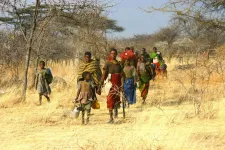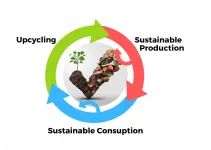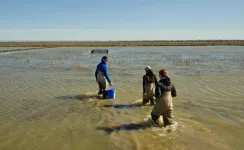(Press-News.org) Navigating, exploring and thinking about space are part of daily life, whether it's carving a path through a crowd, hiking a backcountry trail or maneuvering into a parking spot.
For most of human history, the driving force for day-to-day wayfinding and movement across the landscape was a need for food. And unlike other primates, our species has consistently divided this labor along gender lines.
In new research published in Nature Human Behaviour, scientists including James Holland Jones of Stanford and lead author Brian Wood of University of California, Los Angeles, argue that the increasingly gendered division of labor in human societies during the past 2.5 million years dramatically shaped how our species uses space, and possibly how we think about it.
Underlying these conclusions is a huge and detailed trove of travel data revealing stark differences in the ways men and women among the nomadic Hadza people of Tanzania use space. A contemporary hunter-gatherer society, the Hadza provide a window into a highly mobile lifestyle, which was the norm for our species before the widespread adoption of agriculture.
"We're taking gender differences as a given in this particular cultural setting, and then asking what consequences they have downstream," said Jones, an associate professor of Earth system science at Stanford's School of Earth, Energy & Environmental Sciences (Stanford Earth) and a senior fellow at Stanford Woods Institute for the Environment.
A better understanding of this dynamic could yield clues about why men and women seem to think about space differently. Research in many human populations suggests men and women are better at different types of spatial tasks. On average, women tend to excel on spatial memory tasks, while men tend to score higher on two basic measures of spatial cognition associated with movement: mental rotation of objects and accurately pointing to distant locations.
'Male work is more navigationally challenging'
The paper examines a popular theory that men's hunting for wild game would produce more extensive and sinuous travel, and that women's harvesting of plant foods would lead to more concentrated, straight-line travel to and from known locations.
While previous efforts to substantiate the theory have relied heavily on verbal accounts, the researchers here tested it by examining more than 13,000 miles of travel logged on lightweight GPS trackers worn by Hadza foragers between 2005 and 2018. "One or two researchers would walk through camp early in the morning as people were rousing," the authors write. "We would greet people at their homes or hearths and hand out GPS devices to be worn during the day."
Around nightfall, when most people had returned to camp, Wood and assistants hired in the Hadza community removed the devices. They ultimately used data from 179 people, representing 15 camps and ranging in age from two to 84 years old.
The authors also examined the degree of overlap in the lands visited by men and women. "One of the most surprising results of this study was the fact that Hadza men and women essentially occupy different worlds from a young age. In our data, most of the landscape was effectively gender-segregated," said Wood, an assistant professor of anthropology at UCLA who began working on this paper a decade ago as a postdoctoral scholar at Stanford.
To analyze the movement data, the researchers adopted techniques from the field of movement ecology and also developed custom software. As expected, the results show men walked further per day, covered more land in less direct paths and were more likely to travel alone. "In this hunting and gathering context, male work is more navigationally challenging," the researchers write.
Although some individual day journeys extended to 20 miles or more, Hadza men overall averaged eight miles per day and women - many of them accompanied by young children - averaged nearly five miles. Gender differences emerged by the age of six. From the mid-forties, the gender difference declined, mostly due to decreasing travel by men while women sustained more of their daily mileage.
Human mobility in a changing world
Detailed spatial data like those amassed in this study will aid future comparative research into human mobility, according to the authors. This holds particular resonance in light of a pandemic that has forced sudden revisions of normal movement patterns and heightened attention to the costs and benefits of different spatial habits.
Already, Wood has begun to apply technical, logistical and scientific lessons from this study to a new National Science Foundation project meant to help identify research and policy priorities to prepare the U.S. for inevitable future pandemics - in part by measuring mobility and modeling patterns of social interaction. "The study of human movement can be used to identify at-risk communities for disease transmission and spread," Wood explained.
Even when we're not in a pandemic, Jones said, people's mobility drives economic activity, social cohesion and environmental impacts. And the environment, in turn, shapes spatial behavior. That feedback loop is at the heart of some of the internal migration patterns already emerging as a response to global warming. As once-rare weather events become commonplace, Jones explained, migrant laborers will likely travel longer distances for work; more people will engage in seasonal migration to pursue agricultural work or escape hurricanes and droughts, and crop failures will drive more rural residents to urban areas.
"Changing mobility is going to be one of the key ways that humans adapt to a heated world," Jones said. "Knowing more about gender differences and other drivers for spatial behaviors across a wide swath of human populations and ecological contexts will help us anticipate how this adaptation will play out and inform policies to manage it."
INFORMATION:
The research received funding from the National Science Foundation, the Leakey Foundation, the Wenner-Gren Foundation, the National Geographic Society, Yale University, UCLA and the Max Planck Institute for Evolutionary Anthropology.
Wood is also affiliated with the Max Planck Institute for Evolutionary Anthropology. Coauthors are affiliated with the Max Planck Institute, Arizona State University, University of Southern California, Duke University, University of Chicago, University of Roehampton, University of Nevada, University of Dar es Salaam and University of Utah.
A research team from HSE University and SkolTech, together with experts from the Smorodintsev Research Institute of Influenza in St. Petersburg and the RAS Kharkevich Institute for Information Transmission Problems (IITP), discovered that the SARS-CoV-2 virus independently entered Russia at least 67 times, mostly at the end of February and beginning of March 2020. The vast majority of introductions came from European countries. No cases of introduction from China were registered, which is likely due to the timely closure of borders with the country. Currently, nine local virus lineages are circulating in Russia, which are not present elsewhere in the world. Given that Russia was actively 'importing' the virus from abroad, the researchers have not detected any cases of 'exporting' ...
ROCHESTER, Minn. -- In a new study published in Circulation, Mayo Clinic researchers provide the first preclinical, proof-of-concept study for hybrid gene therapy in long QT syndrome, a potentially lethal heart rhythm condition.
Researchers demonstrated its potential therapeutic efficacy in two in vitro model systems using beating heart cells reengineered from the blood samples of patients with 1 long QT syndrome. They targeted the whole KCNQ1 gene rather than specific LQT1-causative mutations, making this study applicable to all patients with long QT ...
When you think of fungi, what comes to mind may be a crucial ingredient in a recipe or their amazing ability to break down dead organic matter into vital nutrients. But new research by Shuhai Xiao, a professor of geosciences with the Virginia Tech College of Science, and Tian Gan, a visiting Ph.D. student in the Xiao lab, highlights yet another important role that fungi have played throughout the Earth's history: helping the planet recover from an ice age.
A team of scientists from Virginia Tech, the Chinese Academy of Sciences, Guizhou Education University, and University of Cincinnati has discovered the remains of a fungi-like microfossil that ...
A tick saliva study reveals immune responses that could lead to better protection for cattle.
Scientists from Hokkaido University, Japan and Universidade Federal do Rio Grande do Sul and Universidade Federal do Rio de Janeiro, Brazil, have revealed that substances in tick saliva activates immune response-suppressing proteins in cattle that facilitates the transmission of tick-borne diseases. The finding was published in the journal Scientific Reports and could help in the development of alternative control strategies.
The Asian blue tick, Rhipicephalus microplus, feeds on cattle, causing skin lesions, ...
There's a better end for used food than taking up space in landfills and contributing to global warming.
UC Riverside scientists have discovered fermented food waste can boost bacteria that increase crop growth, making plants more resistant to pathogens and reducing carbon emissions from farming.
"Beneficial microbes increased dramatically when we added fermented food waste to plant growing systems," said UCR microbiologist Deborah Pagliaccia, who led the research. "When there are enough of these good bacteria, they produce antimicrobial compounds and metabolites that help plants grow better and faster."
Since the plants in this experiment were grown in a greenhouse, the benefits of the waste ...
Earth is warming rapidly, but there is too little observational data in some regions such as the Arctic or high-altitude areas like the Qinghai-Tibetan plateau to adequately and consistently assess temperature variations across the globe. To better understand how temperatures have increased, an international team led by researchers at Sun Yat-Sen University in China has released a newly merged global surface temperature dataset, including reconstructed land and marine measurements from the 1850s to 2018. The study provides evidence that there was a consistent increased warming trend compared with previous estimations, which closely matches the available observational data and updated simulations covering the past two decades.
The approach ...
A new paper in the Review of Economic Studies, published by Oxford University Press, finds that a generous parental leave policy nurses enjoyed in Denmark caused nursing shortages, which resulted in a decline in the quality of hospital and nursing home care. The study estimates a large increase in nursing home mortality.
Beginning in 1994 a parental-leave program in Denmark offered any parent the opportunity to take up to a full year off work, paid, for every child under the age of nine. The researchers find that many nurses in Denmark took advantage of this program. Nurses, however, could not be replaced on net despite the Danish government's efforts to expand education and immigration ...
If you look deep into the eyes of a fish, it will tell you its life story.
Scientists from the University of California, Davis, demonstrate that they can use stable isotopic analysis of the eye lenses of freshwater fish -- including threatened and endangered salmon -- to reveal a fish's life history and what it ate along the way.
They conducted their study, published today in the journal Methods in Ecology and Evolution, through field-based experiments in California's Central Valley. The study carries implications for managing floodplains, fish and natural resources; prioritizing habitat restoration efforts; and understanding how landscape disturbances impact fish.
The technique had previously been used in marine environments, ...
Worldwide, over one billion people live with a disability. Historically, they have been discriminated against and stigmatized by society. To improve their rights, they should be included in political decision-making, yet there is a lack of political representatives who are known to have a disability. This under-representation may be due to several factors, including how voters perceive a political candidate with a disability. However, a new study published in Frontiers in Political Science, found for the first time that voters do not apply negative stereotypes when evaluating candidates with a disability. Rather, voters tend to perceive candidates with a disability as capable, ...
Prescription drug prices in the United States are significantly higher than in other nations, with prices in the U.S. averaging 2.56 times those seen in 32 other nations, according to a new RAND Corporation report.
The gap between prices in the U.S. and other countries is even larger for brand-named drugs, with U.S. prices averaging 3.44 times those in comparison nations.
The RAND study found that prices for unbranded generic drugs -- which account for 84% of drugs sold in the U.S. by volume but only 12% of U.S. spending -- are slightly lower in the U.S. than in most other nations.
"Brand-name drugs are the primary driver of the higher prescription drug prices in the U.S.," said Andrew Mulcahy, lead author of the study and a senior health policy researcher at RAND, a ...





